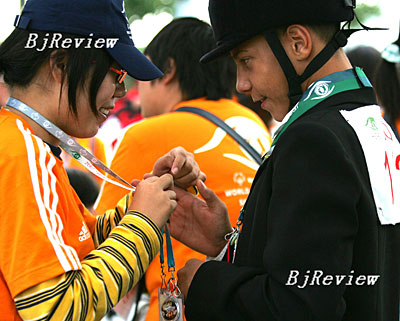
Between October 2 and 11, the Special Olympic Summer Games were hosted in Shanghai, the first time the 40-year-old athletic competition for people with intellectual disabilities has come to a developing country. This Special Olympics was also larger than all previous games in terms of the number of athletes.
Shanghai people have always been proud of living in one of China's best-known cities in the world, which has been an important economic powerhouse over the last 30 years. In recent years, the city has forged a new identity as hometown for two global sports stars: Liu Xiang, the first Asian athlete to win the men's 110m hurdles in the Olympic Games, and the 7.6-feet NBA star center Yao Ming.
The Special Games has created a new national sports star out of 19-year-old Zhao Zengzeng, an ambassador and Olympian of the event. Over the one year before the Special Olympics, the lovely smile of Zhao had become the signature image for Special Olympians in Shanghai and around China. Since 2006, a TV commercial featuring a sweating Zhao doing long-distance running, with a big smile on her face, has been shown all day on huge plasma screens along the bustling streets of this cosmopolitan city and by national TV broadcaster, China Central Television. A poster of the Special Olympics with Zhao in the costume of the national team, with lipstick kiss marks on her face and arms, has appeared in almost every public venue in Shanghai.
Zhou Baomei, a teacher at a school for intellectually challenged children in Shanghai, is also a celebrity of the 2007 Special Olympics. In a competition to design the logo for the 2007 Special Olympics in 2005, Zhou's design defeated 1,476 submissions from some 10 countries and eventually became the official logo.
The logo is shaped like an eye with the figures of two athletes jumping in the pupil, resembling a blooming white magnolia, Shanghai's city flower. Using freehand brushwork as in traditional Chinese painting, it conveys a strong, appealing message.
Zhou said the design is inspired by the yearning stares of her students during her teaching. "When intellectually disabled people meet setbacks and difficulties in life, they look forward to encouraging stares from us. When they walk into society, they hope that they can be accepted and treated equally, which they will know for sure from people's eyes."
Hosting the Special Olympics has activated the whole city to show it cares for intellectually disabled people. Over 1,800 families in Shanghai played host to Special Olympic athletes before and during the games. A total of 40,000 volunteers were assiduously trained on how to provide life assistance to the athletes.
Since 2005, community homes for intellectually disabled people have been set up across Shanghai. At these community homes, graduates of schools for the intellectually disabled can receive vocational training, do exercise, receive rehabilitation training and work to earn a salary. By April, the total number of community homes in Shanghai had reached 240.
The caring for athletes can be found in every detail of the organizing work for the games. To guarantee the safety of the athletes for the marathon, a total of 485 working staff were arranged to take care of the 23 athletes during the race. That meant on average that one athlete could be assisted by 23 people. At the cycling stadium staff arrived before 8 o'clock each day to scrutinize every inch of the track, making sure not even a pebble was left on the track that could hamper the athletes' safety during the competition.
The swimming stadium imported a special device to put swimmers with serious intellectual disabilities into the water if they were not able to jump from a platform. Since the ground around the swimming pools was wet and slippery, every swimmer was also accompanied by at least one volunteer once he or she climbed out of the pool.
